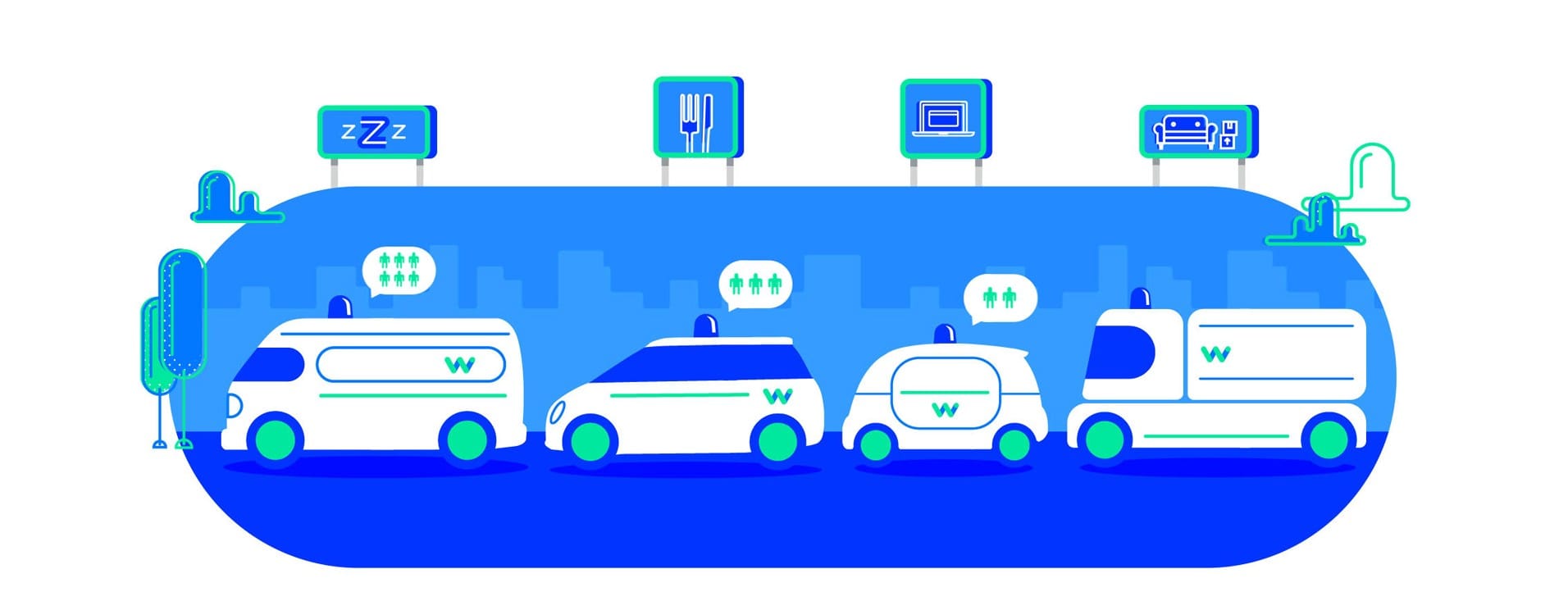Egal wie weit selbstfahrende Autos, Marke Level 5 (siehe hier für eine Erklärung der Autonomie-Level), noch weg sind. Sie sind näher als die Skeptiker denken.
Wie bereits seit geraumer Zeit gemunkelt, hat Waymo jetzt den ersten Dienst mit selbstfahrenden Taxis gestartet. Sprich: Es sitzt kein Mitarbeiter mehr am Lenkrad um notfalls einzugreifen. Kleine Schritte: Es sitzt noch ein Mitarbeiter hinten beim Gast, um notfalls einzugreifen.

Für Waymo ist der driverless service der erste Schritt zum ersten echten Produkt. Techcrunch:
at Web Summit today, Waymo CEO John Krafcik confirmed that Waymo’s first focus in terms of commercialization will be deploying a “Waymo driverless service.”
Such a service will probably resemble the current autonomous ride-hailing trial Waymo is running in Chandler, Arizona near Phoenix. For that pilot, select members of the public are able to hail a Waymo self-driving Chrysler Pacifica minivan, which then autonomously navigates to their position, picks them up, and brings them on to their destination, all managed from an app. Onboard, there’s a start/stop button, climate controls, displays for monitoring the ride route and a one-click support button for speaking to a live agent.
Krafic said on stage that Waymo is “now working on making this commercial service available to the public,” and that “getting access will be as easy as using an app.” The service will send Waymo vehicles to riders on demand, without anyone at all on board, which will ensure that riders “have [their] own personal spaces where [they] can set back and relax, according to Krafcik.
Hier beschreibt Waymo den Service auf Medium:
After more than eight years of development, we’re taking the next step toward unlocking the potential of fully self-driving technology. [...] Over time, we’ll cover a region that’s larger than the size of Greater London, and we’ll add more vehicles as we grow.
Über die bisherige Reise von Waymo:
We prepared for this next phase by putting our vehicles through the world’s longest and toughest ongoing driving test. Since we began as a Google project in 2009, we’ve driven more than 3.5 million autonomous miles on public roads across 20 U.S. cities. At our private test track, we’ve run more than 20,000 individual scenario tests, practicing rare and unusual cases. We’ve multiplied all this real world experience in simulation, where our software drives more than 10 million miles every day.
Waymo will deutlich auf der Basis der Technologie ein breites Produktportfolio aufbauen:
With Waymo in the driver’s seat, we can reimagine many different types of transportation, from ride-hailing and logistics, to public transport and personal vehicles, too. We’ve been exploring each of these areas, with a focus on shared mobility. By giving people access to a fleet of vehicles, rather than starting with a personal ownership model, more people will be able to experience this technology, sooner. A fully self-driving fleet can offer new and improved forms of sharing: it’ll be safer, more accessible, more flexible, and you can use your time and space in the vehicle doing what you want.
Für den öffentlichen Personennahverkehr kann das heißen: In ein paar Jahren Busse statt von MAN von Waymo kaufen. Waymo könnte der wichtigste Lieferant für den öffentlichen Nahverkehr werden. Wie die Arbeitsteilung hier zwischen einem Waymo und dem ÖPNV aussehen wird, ist noch eine offene Frage.
Aber spannend ist sie allemal: Besonders die aktuelle Lyft/Waymo-Aufteilung zeigt, dass hier Systeme verknüpft werden können. In Verbindung mit der nachhaltigeren Kleinteiligkeit bei selbstfahrenden Vehikeln kann das Tür-zu-Tür-Problem des ÖPNV massiv gelindert werden.
Ars Technica über die kleinen Schritte, die Waymo mit seinem Pilot-Projekt jetzt macht:
At first, most of Waymo's driverless cars will have an employee in the back observing the vehicle's behavior. If something goes really wrong, they'll be able to push the "pull over" button to stop the car. In the coming months, participants in Waymo's early rider program will start getting the option to ride in fully driverless vehicles.
Some time after that, Waymo will launch a commercial driverless taxi service that's open to members of the general public in the Phoenix metropolitan area and beyond.
Über Phoenix als erste Testumgebung hatten wir bereits geschrieben:
Für Phoenix spricht grundsätzlich ‚gutes Wetter‘ das ganze Jahr über und Straßen, die in Gitter-Form angelegt sind. Einfach mal beim Kartenanbieter des Vertrauens den Bezirk Chandler in Phoenix anschauen.
Ars Technica verweist zusätzlich auf das regulatorisch angenehme Wetter für Waymo:
A big advantage of starting in Phoenix is the region's excellent weather. It's warm and sunny there almost every day. Tricky situations like rain, snow, and ice are rare—though Waymo says its cars are able to drive safely in light rain. Waymo recently expanded its testing into Detroit to prepare for an eventual expansion of the service into colder parts of the United States.
In addition to nice weather, the Phoenix area has wide, well-maintained streets and less traffic congestion than most major cities. [...]
Arizona's leaders have bent over backward to attract Waymo and other self-driving car makers to the Phoenix area. Arizona Gov. Doug Ducey signed a two-page executive order in 2015 designed to encourage self-driving car testing in the state. Besides that, Arizona doesn't have any special legislation or regulations related to self-driving cars.
Ars Technica beschreibt im Artikel auch gut das aktuelle Innenleben der Waymo-Taxis und zeigt Fotos.
In der Zwischenzeit macht just ein Unfall eines selbstfahrenden Busses in Las Vegas gerade die Runde.
Hier ein Augenzeugenbericht auf Yahoo News:
The bus drives very conservatively. If it senses a person walking across the street ahead, it stops. If there’s traffic on the street when it’s at a stop, it waits for the road to clear. It goes along at about 20 mph, and it’s a really gentle ride. The self-driving shuttle does exactly what it’s supposed to do.
On our ride, we encountered a medium-large articulated delivery truck stopped in the street. The driver was trying to back his trailer into an alleyway on the left. The shuttle bus very obediently stopped a reasonable distance from the truck and waited for it to move. That’s where things went wrong.
What the autonomous shuttle bus didn’t expect was that the truck would back up towards it. As the driver was swinging the trailer into the alley, the tractor portion of the truck was coming right at us – very slowly. We had plenty of time to watch it happen. I was taking pictures.
Das klingt unspektakulär. Dazu kommt, dass der menschliche Fahrer des Trucks die Schuld trägt. Yahoo:
The driver of the truck was probably watching where his trailer was going, and didn’t notice where we were. The so-called “crash” happened in super slow motion, and merely dented the plastic panels on the front of the shuttle. It was no big deal, although the Keolis attendant was understandably upset.
This collision, like 90 percent of traffic incidents on our roads, was the result of human error. The truck driver got a ticket from the Las Vegas police. We could see his mirrors the whole time and he should have seen us. But I don’t want to be too harsh on the guy – driving a big truck in Las Vegas is a tough job, and he’s only human. His error could have happened to anyone.
Dass in den Medien trotzdem von einem Unfall die Rede ist, der von einem selbsfahrenden Bus verursacht wurde, sollte niemanden überraschen. So funktionieren Massenmedien. Im Zweifel ist immer das Neue schuld. Oder anders: Das Neue genießt keine Unschuldsvermutung, es muss seine Qualitäten erst selbst beweisen. (Und selbst dieser Beweis muss nicht zwingend ausreichen.)
Deshalb bleibt das Waymo-Pilotprojekt, trotz sorgfältig ausgesuchter Gegend, ein Spiel mit dem Feuer.
auto connected car news über die durchaus berechtigten Bedenken:
“The most recent required public ‘disengagement reports’ in California show Waymo’s robot cars aren’t ready to roam the roads without a human driver monitoring them,” said John M. Simpson, Consumer Watchdog’s Privacy Project Director. “There is no such public information in Arizona. CEO John Krafcik is simply asking us to trust him as he uses public roads as a private laboratory. That’s simply not good enough.” [...]
Waymo’s most recent California disengagement reports released earlier this year show that its robot cars aren’t ready to be turned loose on our highway, Consumer Watchdog said. The required reports show Google’s Waymo robot technology failed 124 times in 635,868 miles. Waymo said disengagements declined from 341 in 2015 to 124 in 2016, or 0.8 per 1,000 miles compared to 0.2 per 1,000 miles. While there has been an improvement, the reports show the robots simply aren’t ready to be released to roam our roads without human drivers, Consumer Watchdog said.
“Putting robot cars on public roads without any kind of driver’s license amounts to giving the manufacturer a license to kill,” said Simpson.
Disengagements pro 1,000 Meilen werden für die Straßen im Chandler-Bezirk von Phoenix weitaus geringer sein. Bezeichnend natürlich auch, dass Waymo die Zahl trotzdem nicht freiwillig zum Start veröffentlicht.
Wenn die Technologie sich schnell genug weiterentwickelt, könnten Medien und Regulierer sich allerdings schnell einem zweiten Uber gegenüber sehen: Geliebt von der Bevölkerung trotz massiver öffentlicher professioneller Kritik.

